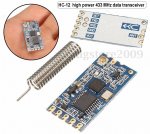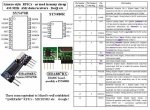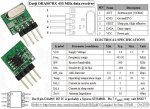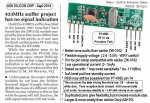Hi,
I have a setup with 2 Picaxe 14M2 and 2 Gorji TX and RX with the following pgms:
#Picaxe 14M2
#Terminal 4800
MAIN:
high b.3
pause 2000
low b.3
pause 100
rfout b.5, ("aaaaaaaa")
sertxd ("aaaaaaaa",cr,lf)
pause 2000
goto MAIN
#Picaxe 14M2
#Terminal 4800
MAIN:
high b.3
pause 500
low b.3
sertxd ("START",cr,lf)
low c.1 ;enable the receiver
pause 100
rfin c.0, b1,b2,b3,b4,b5,b6,b7,b8
high c.1
sertxd (b1,b2,b3,b4,b5,b6,b7,b8,cr,lf)
goto MAIN
which dont work.
Sometimes the receiving pgm receives 8 bytes, but they are garbled - most of the time the receiving pgm receives nothing.
I have had the pgms work with serout/serin.
A scope shows that the transmitter transmits and it looks regular as "aaaaaaaa" should. The scope also shows that the receiver is enabled and appears to receive data (but that is normal for the Gorji receiver), but the rfin statement does not get executed.
Can anybody help?
The 17/3-12 Goytex wrote that he had tried the Doji with rfout and rfin - and it worked. But how?
best regards
torben
I have a setup with 2 Picaxe 14M2 and 2 Gorji TX and RX with the following pgms:
#Picaxe 14M2
#Terminal 4800
MAIN:
high b.3
pause 2000
low b.3
pause 100
rfout b.5, ("aaaaaaaa")
sertxd ("aaaaaaaa",cr,lf)
pause 2000
goto MAIN
#Picaxe 14M2
#Terminal 4800
MAIN:
high b.3
pause 500
low b.3
sertxd ("START",cr,lf)
low c.1 ;enable the receiver
pause 100
rfin c.0, b1,b2,b3,b4,b5,b6,b7,b8
high c.1
sertxd (b1,b2,b3,b4,b5,b6,b7,b8,cr,lf)
goto MAIN
which dont work.
Sometimes the receiving pgm receives 8 bytes, but they are garbled - most of the time the receiving pgm receives nothing.
I have had the pgms work with serout/serin.
A scope shows that the transmitter transmits and it looks regular as "aaaaaaaa" should. The scope also shows that the receiver is enabled and appears to receive data (but that is normal for the Gorji receiver), but the rfin statement does not get executed.
Can anybody help?
The 17/3-12 Goytex wrote that he had tried the Doji with rfout and rfin - and it worked. But how?
best regards
torben








